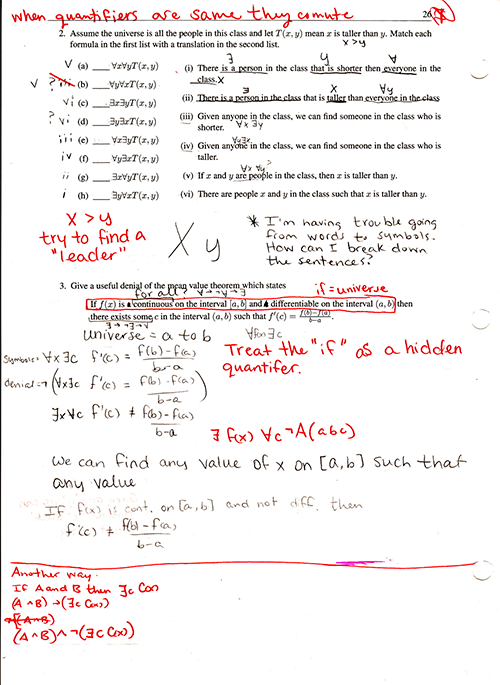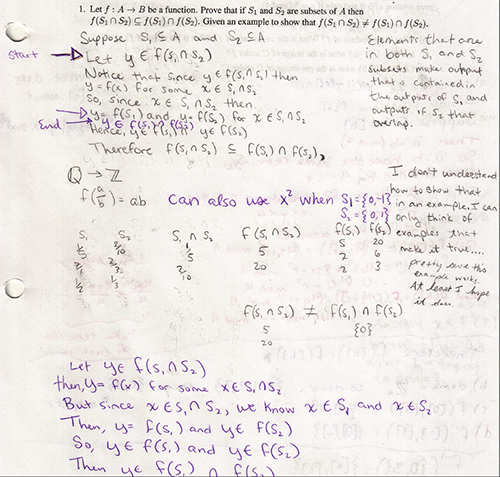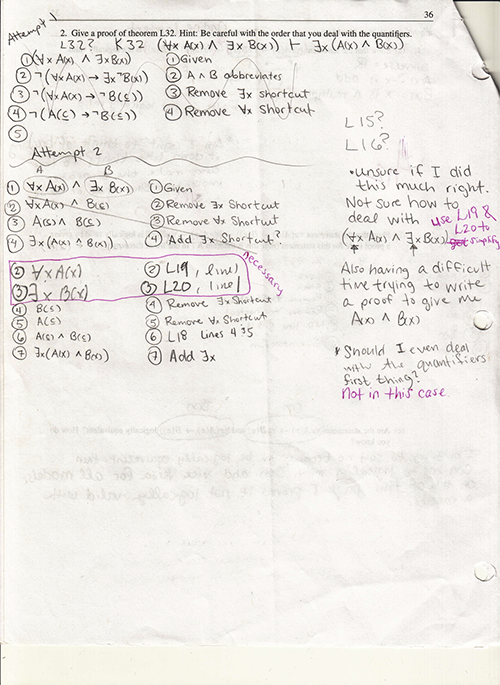Inquiry-based Learning: Using Presentation Homework Problems to Enhance Engagement
Contents
Introduction
If you ask students, academia is full of right and wrong answers. However, Dr. Vicki Klima, Professor of Mathematical Sciences, disagrees: “I think that in general, we believe that math is about the right answer. But it’s not so much about the right answer. It’s about logical thinking. And the way we progress through to the solution is more important than the number that you write at the end.”
In her algebra classes at Appalachian State University, Dr. Klima utilizes an inquiry-based learning approach called presentation problems. In this method, students attempt to solve a mathematical problem, work towards a solution, and write down their questions in places where they are stuck. Then, in class, a student is asked to present the problem and their solution on the board for the class to discuss. Students then correct their work or answer their questions during the class review. The technique emphasizes process over product and identification of strengths as well as weaknesses; it reduces student stress, and increases student involvement. Best of all, it is a practice that can be applied across disciplines.
UDL Alignment
Each College STAR module explains how a particular instructional practice described within the module aligns with one or more of the principles of UDL. This module aligns with Provide Multiple Means of Action and Expression, Principle II; and Provide Multiple Means of Engagement, Principle III.
Module Alignment with Provide Multiple Means of Action and Expression
The practice of implementing presentation problems aligns with UDL Principle II: Provide Multiple Means of Action and Expression. In particular, presentation problems align with Guideline 6.4: Enhance capacity for monitoring progress. Dr. Vicki Klima grades her algebra homework presentation problems by evaluating what students have prepared before class-specifically what questions they posed in parts of the solution and the answers to these questions that they wrote during the class discussion of the solution. By encouraging students to articulate their questions when they unsure of the next step, Dr. Klima is helping students become more cognizant of their learning. Students pinpoint exactly where in the process they need help to solve an individual algebra problem-as well as that category of problems and the course as a whole. Thus presentation problems teach students a methodology for solving all problems. Students encounter many unfamiliar and confusing situations in college in which they do not know how to proceed; however, by making an attempt to solve a problem and posing questions where they are confused or unsure, students appropriately approach the solution to any problem.
Module Alignment with Provide Multiple Means of Engagement
This module also aligns with Principle III: Provide Multiple Means of Engagement, specifically the following Guidelines-8.2: Vary demands and resources to optimize challenge; 8.3: Foster collaboration and communication; 8.4: Increase mastery oriented feedback; and 9: Provide options for self-regulation. Dr. Klima assigns three to four problems a week for homework; students work to the best of their ability; then all discuss the solution as one student presents a solution on the board. Since the demands and challenges of these homework problems can vary, the opportunity to note questions when students become stuck in a solution allows more collaboration and communication. By writing and answering their own questions with the support of others, students learn not only to target their inquiry, but also to internalize the ability to offer and receive critical feedback. This process offers multiple opportunities for self-regulation in motivation, coping skills, and self-assessment and reflection.
Instructional Practice
This module covers information about Inquiry-based Learning, which is clearly linked to the principles of Universal Design for Learning–Multiple Means of Action and Expression, and Multiple Means of Engagement.
In her junior-level algebra classroom, Dr. Vicki Klima assigns three or four homework problems per week. Students attempt to solve each problem, noting places when they are confused or unsure of how to proceed. In each of these places, students frame their note as a question.
In class then she asks one student to present his solution to one of the homework problems on the board. The student may or may not have arrived at the correct solution, but Dr. Klima leads a discussion about the student’s logic and process of solving the problem. As they proceed through the solution, students in their seats are following long; when they come to a place in their own solution where they posed a question, they write the answer to that question on their homework paper. However, they are not cheating. In fact their grade depends on those answers that they record during class.
This process, known as presentation problems, comes from a principle of inquiry-based learning that Dr. Klima utilizes in her classroom. It is a practice noted for its effectiveness by her students:
The Problem
Sometime ago, Dr. Klima noticed a pattern with her students: “Oftentimes when people read a problem and they don’t know how to do it, they just skip it. Like if they don’t know how to do it, then they won’t attempt it.” So she implemented presentation problems in her algebra classes.
In presentation problems, students complete homework problems to the best of their ability and note significant questions in places where they cannot determine the next step. Once a week, Dr. Klima asks one of the students to write his solution on the board; at the same time, Dr. Klima leads the class in a discussion of the logic behind each step. During the discussion, students use a colored pen to correct their own homework solutions. Only then is the homework passed to Dr. Klima who grades it based on their homework completed before class as well as on the notes made on the homework in colored ink during class. Below are two samples of student work done in Dr. Klima’s MAT 2110 class. In both samples, students have written questions they had while attempting the homework and have corrected their own work.
 Figure 1: “Student Sample 1-Asking Questions and Correcting Work”
Figure 1: “Student Sample 1-Asking Questions and Correcting Work”
 Figure 2: “Student Sample 2-Asking Questions and Correcting Work”
Figure 2: “Student Sample 2-Asking Questions and Correcting Work”
As opposed to traditional methods that emphasize the correct answer, presentation problems emphasize the process of solving problems. Not only do the students attempt to solve all homework problems, but they also identify what part(s) of the process they do not understand. By writing a question, rather than just noting a confusing step, they have to think logically and critically about the process and what is confusing for them. Since Dr. Klima grades not on the correct solution as first attempted, but on the question and answer process, students experience less stress and are more likely to ask questions in class and lecture.
Process Not Product
Dr. Klima emphasizes the importance of process in the math discipline. Presentation problems encourage students to at least attempt the parts of the problem they do not know how to solve completely. In her class discussion of each problem, Dr. Klima asks questions such as, “What is going on in this line?” and “Why did she do this next?” If the presenting student’s answer is incorrect, the class corrects it together.
Dr. Klima also asks students to answer their own questions. If a student’s question does not surface in the discussion, the student needs to ask the question directly. Further, Dr. Klima requires students to always write something on their homework during the class discussion. Even if their solution is correct, they are encouraged to present an alternative method or a concept that they did not previously consider. Each of these steps continuously underscores the importance of how the student arrived at the solution rather than the correct number at the bottom of the page. In Sample 3, the student has written several questions to the right of their attempt and has then answered those questions based on class discussion.
 Figure 3: “Student Sample 3-Answering Questions”
Figure 3: “Student Sample 3-Answering Questions”
Identifying Strengths and Weaknesses
By asking them to write questions and then answer these questions during presentation problems, students are learning how to identify their own strengths and weaknesses. Dr. Klima states, “I think it’s helpful for them to write a question when they get stuck because then they can see where in the process they’re having difficulties and address those difficulties and improve their process of thinking in the future.”
Not only do students identify and address their own weaknesses, but by reading the class homework results, Dr. Klima is able to monitor the class as a whole as to where in the process the students may be struggling. She explains, “I get a better idea of where people are struggling instead of just that they are struggling. I can see that they understand the definitions really well, but are struggling with a specific theorem. So I can pinpoint where the students are struggling better.” By having her finger on the pulse of the class, and having specific data on which part of the process students are not grasping, Dr. Klima can adjust her instruction to address concepts that the majority of the class is missing.
Reducing Stress
Dr. Klima most often receives student feedback about how less stressed they feel with regard to their homework grades. Since students are graded on understanding the process—rather than submitting the right answer—it relieves much of the pressure of needing to understand everything about the problem before class begins. Creating a less stressful environment leads to greater capacity to learn from the experience. Dr. Klima notes, “[Being graded on their process] allows them to think about the problems and get credit for thinking about the problems without being worried about a grade on the final solution. Not everybody gets a perfect score because some people don’t correct their problem or answer their questions. But if they are careful students, they don’t have to already know how to do the problem, it’s about learning. So it rewards students for their work instead of their knowledge at the time. Then they hopefully gain that knowledge through the discussion.”
Increasing Student Involvement
Although she hasn’t collected data, Dr. Klima has noticed an increase in student involvement in her classes since the implementation of presentation problems. Since class discussion does not revolve around “right” versus “wrong,” students participate in the discussion of each problem. She also noticed that having students write questions for homework and answer them in class, it makes them more likely to ask questions during lectures. She posits that by encouraging an atmosphere of inquiry, students who may be less confident in their skills may be willing to share more, thus increasing their confidence in the classroom.
Broad Application
Presentation problems are seen to be effective in the algebra classroom (Konstantinou-Katzi, Tsolaki, Meletiou-Mavrotheris, & Koutselini, 2013); however the process and rationale can be applied to other disciplines. Altering grading policies to reflect process over product may increase student engagement in class and decrease stress. Having students write and answer their own questions in any discipline teaches students to identify their strengths and weaknesses.
Inquiry-based learning has a strong foundation in the sciences. Much like Dr. Klima’s presentation problems in mathematics, instructors in the sciences have used inquiry to guide student research in their classes (Gormally, Brickman, Hallar, & Armstrong, 2011). However, the practice is not limited to the STEM disciplines. Researchers discussing ways of incorporating inquiry-based practices in the collegiate classroom suggest that professors use the way they think about scholarship as a starting point to guiding student inquiry into the discipline (Lee, 2011). For example, a history professor may encourage students to share their process of inquiry in a research paper, highlighting their struggles and receiving class support in their draft papers.
Learn More
Literature Base
Inquiry-based learning is a teaching practice that emphasizes student exploration and investigation (Educational Broadcasting Corporation, 2004). In inquiry-based learning experiences, students are encouraged to ask broad questions that integrate disciplines in order to gain a deeper understanding of the material. Inquiry-based practices often increase student conceptual understanding and engagement (Gormally, Brickman, Hallar, & Armstrong, 2011). Utilizing inquiry-based practices in the mathematical sciences, where students direct their own learning, has improved student grades (Konstantinou-Katzi, Tsolaki, Meletiou-Mavrotheris, & Koutselini, 2013). Professors need to adapt their role in implementing inquiry-based practices (Gormally, Brickman, Hallar, & Armstrong, 2011) from “sage” to “guide.” They need to help students to ask and research meaningful questions, instead of easily offering answers. They need to alter their own questions for scholarship, into questions for their students (Lee, 2011).
Inquiry-based learning experiences have also shown to be an effective model for on-line classes (Kong & Song, 2014). Additionally, in comparison to regular classroom approaches, inquiry-based learning approaches have decreased student resistance and attention seeking behaviors over the short-term in middle school science classes (Sever & Guven, 2014).
References & Resources
CAST. (2009). CAST UDL online modules. Retrieved from http://www.cast.org
CAST. (2011a). Universal design for learning guidelines version 2.0. Retrieved from http://www.cast.org
CAST. (n.d.). About CAST: What is universal design for learning. Retrieved from http://www.cast.org
EnACT. (n.d.). 14 common elements of UDL in the college classroom.
Evans, C., Williams, J., King, L., & Metcalf, D. (2010). Modeling, guided instruction, and application of UDL in a rural special education teacher preparation program. Rural Special Education Quarterly, 29(4), 41.
Gormally, C., Brickman, P., Hallar, B., & Armstrong, N. (2011). Lessons learned about implementing an inquiry-based curriculum in a college biology laboratory classroom. Journal of College Science Teaching, 40(3), 45-51.
Immordino-Yang, M. H., & Damasio, A. (2007). We feel, therefore we learn: The relevance of affective and social neuroscience to education. Mind, Brain, and Education, 1(1), 3-10. doi:10.1111/j.1751-228X.2007.00004.x
Kong, S. C., & Song, Y. (2014). The impact of a principle-based pedagogical design on inquiry-based learning in a seamless learning environment in hong kong. Educational Technology & Society, 17(2), 127.
Konstantinou-Katzi, P., Tsolaki, E., Meletiou-Mavrotheris, M., & Koutselini, M. (2013). Differentiation of teaching and learning mathematics: An action research study in tertiary education. International Journal of Mathematical Education in Science and Technology, 44(3), 332-349.
Lee, V. S. (2011). The power of inquiry as a way of learning. Innovative Higher Education, 36(3), 149-160.
National Center on Universal Design for Learning. (2011). About UDL. Retrieved from http://www.udlcenter.org/aboutudl
Rose, D. H., Harbour, W. S., Johnston, S. G., & Abarbanell, L. (2006). Universal design for learning in postsecondary education: Reflections on principles and their application. Journal of Postsecondary Education & Disability, 19(2).
Rose, D. H., & Meyer, A. . Teaching Every Student in the Digital Age: Universal Design for Learning, http://www.cast.org
Rose, D., & Dalton, B. (2009). Learning to read in the digital age. Mind, Brain, and Education, 3(2), 74-83. doi:10.1111/j.1751-228X.2009.01057.x
Sever, D., & Guven, M. (2014). Effect of inquiry-based learning approach on student resistance in a science and technology course. Educational Sciences: Theory & Practice, 14(4), 1601-1605.
UDLCAST. (2011). Introduction to UDL. Retrieved from http://www.youtube.com/watch?v=MbGkL06EU90&feature=relmfu
Additional Resources
APA style: A DOI primer. Retrieved from from http://blog.apastyle.org/apastyle/2009/09/a-doi-primer.html
CAST: Center for applied special technology. Retrieved from http://www.cast.org
CrossRef. (2002). DOI resolver. Retrieved from http://www.crossref.org
International DOI Foundation. (2012). Resolve a doi number. Retrieved from http://www.doi.org
Mazur, E. (2013). Assessment, The Silent Killer of Learning. Retried from https://www.youtube.com/watch?v=CBzn9RAJG6Q
About the Author

Vicki Klima
Department of Mathematical Sciences
Appalachian State University